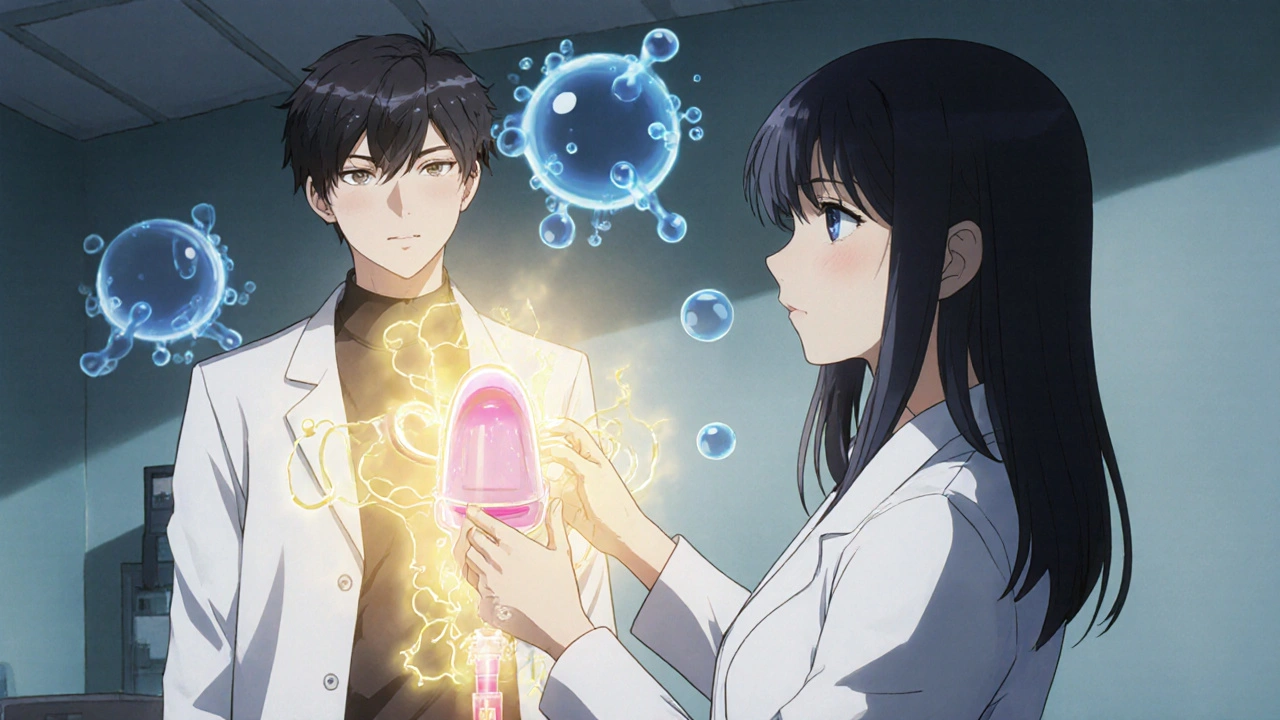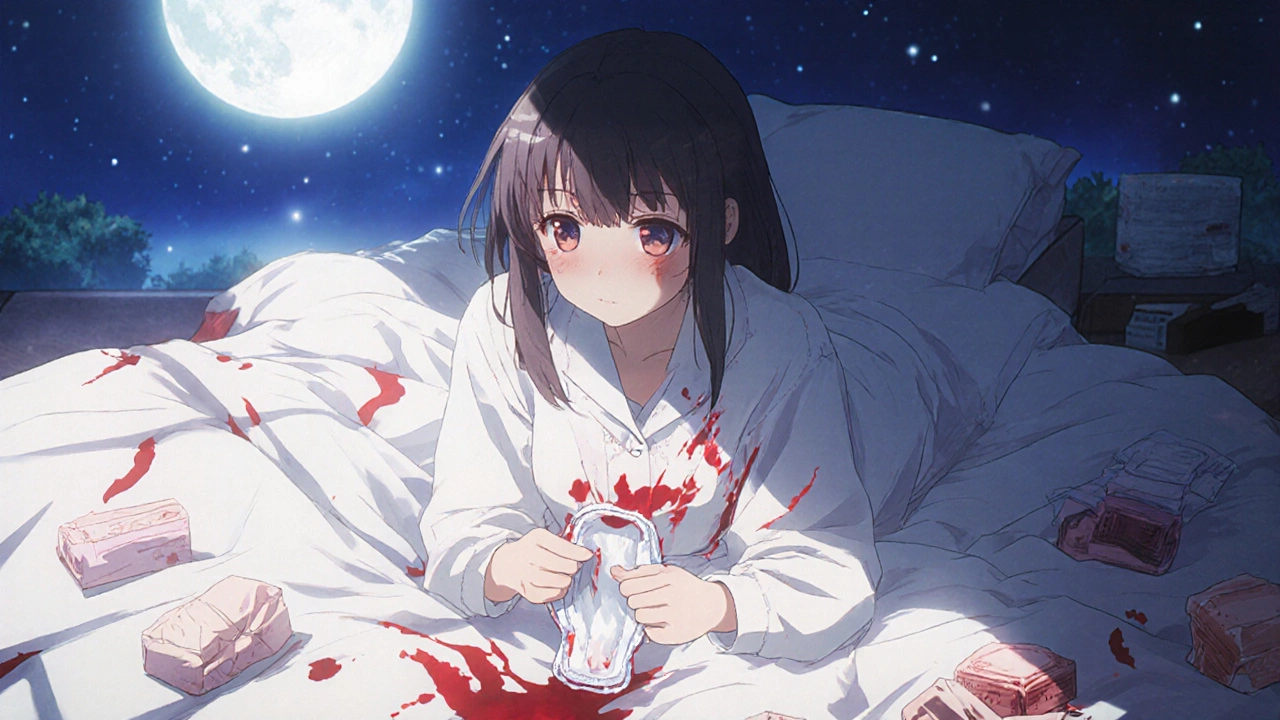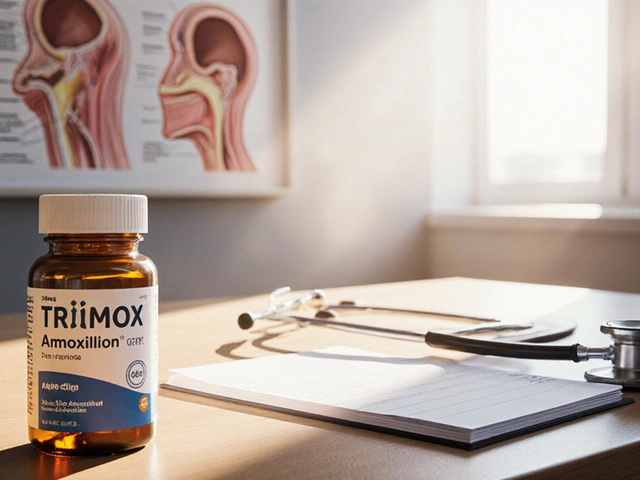If you’re on a blood thinner and your periods have suddenly become unbearable, you’re not alone-and you’re not imagining it. About 70% of menstruating women taking oral anticoagulants experience heavy menstrual bleeding (HMB) that affects their daily life. This isn’t just a "side effect"-it’s a common, under-recognized complication that can lead to iron deficiency, missed work, anxiety, and even stopping your life-saving medication altogether.
Why Blood Thinners Make Periods Heavier
Blood thinners, also called anticoagulants, work by preventing clots from forming in your blood vessels. That’s great for preventing strokes, deep vein thrombosis, or pulmonary embolisms. But your uterus is made of tissue that naturally sheds and bleeds each month. When anticoagulants interfere with clotting, that shedding doesn’t stop as it should. The result? Excessive, prolonged bleeding.It’s not just warfarin. Newer drugs called direct oral anticoagulants (DOACs)-like apixaban, rivaroxaban, dabigatran, and edoxaban-are just as likely to cause this problem. In fact, a 2022 study in Blood found that two out of three women who started any blood thinner had abnormally heavy periods within months. That’s far higher than the 10%-30% of women who normally experience heavy bleeding.
Some DOACs carry more risk than others. Research shows rivaroxaban is linked to the highest rates of HMB, while apixaban and dabigatran appear to be slightly safer. But no blood thinner is completely free from this risk. And here’s the kicker: most doctors don’t ask about it.
What Heavy Bleeding Actually Looks Like
It’s not just "a lot of blood." Heavy menstrual bleeding on anticoagulants has clear signs:- Changing pads, tampons, or menstrual cups every 30-60 minutes
- Leaking through products despite using the highest absorbency
- Passing clots larger than a quarter
- Periods lasting longer than 7 days
- Feeling dizzy, tired, or short of breath from blood loss
- Needing to plan your day around bathroom access
Many women report carrying emergency changes in their bags, avoiding social events, or skipping work because they’re afraid of an accident. One woman on Reddit said she had to leave her job because she was bleeding through three pads an hour. Another said she cried in the bathroom after her first period on Eliquis-she’d never bled this much in her life.
Left untreated, this bleeding can lead to iron deficiency anemia. That means fatigue, brain fog, heart palpitations, and brittle nails. It’s not just inconvenient-it’s medically serious.
The Hidden Danger: Stopping Your Blood Thinner
It’s tempting to skip doses or quit your medication when your periods are out of control. But that’s incredibly dangerous.Research from Dr. Bethany Samuelson Bannow at Oregon Health & Science University shows that skipping or stopping anticoagulants increases your risk of a recurrent blood clot by five times. A clot in your lung or brain can kill you. A heavy period won’t-but it can make you want to risk it.
This is why the solution isn’t to stop the blood thinner. It’s to treat the bleeding while staying on it. You don’t have to choose between safety and quality of life.

Effective Treatment Options (That Won’t Stop Your Blood Thinner)
There are proven, safe ways to reduce heavy bleeding without stopping your anticoagulant. Here’s what works:1. Levonorgestrel IUD (Mirena, Kyleena, etc.)
This is the gold standard. A small T-shaped device is placed in your uterus and releases a form of progesterone directly into the uterine lining. It doesn’t affect your blood clotting system. In clinical studies, it reduces menstrual blood loss by 70%-90% within 3-6 months. Many women stop bleeding altogether.
One woman on the r/anticoag subreddit shared: “After getting the Mirena, my periods went from ER visits to almost nothing-while staying on Eliquis.” That’s the kind of result you can expect.
2. Progestin Pills (Norethisterone)
The American Society of Hematology recommends a high-dose, short-term regimen: 5 mg of norethisterone three times a day for 21 days, starting a few days before your period. This thickens the uterine lining and reduces shedding. It’s not a long-term fix, but it’s excellent for acute control.
3. Tranexamic Acid
This is a prescription medication that helps your blood clot locally-in your uterus, not elsewhere in your body. It’s taken only during your period (usually 4 times a day for up to 5 days). Studies show it cuts bleeding by 30%-50%. It’s safe to use with DOACs and warfarin, as long as you don’t take it every day-just during your cycle.
4. Hormonal Birth Control (Pills, Patch, Ring, Implant)
Combined estrogen-progestin methods can regulate cycles and reduce bleeding. But estrogen can slightly increase clot risk, so they’re not always recommended if you’re already on anticoagulants for a clotting condition. Progesterone-only options-like the implant (Nexplanon) or the shot-are safer and effective. Ask your doctor which fits your medical history.
What Doesn’t Work (and What to Avoid)
Some common suggestions can actually make things worse.
- NSAIDs like ibuprofen or aspirin: These can reduce bleeding by 20%-40% in some women, but they also thin blood. Combining them with anticoagulants raises your risk of dangerous bleeding. Only use them if your doctor says it’s safe.
- Endometrial ablation: This procedure burns or removes the uterine lining. It works well for women not on blood thinners, but for you, it’s risky. You’d need to stop your anticoagulant temporarily-which could trigger a clot. Plus, you’d still need birth control afterward. It’s a last resort.
- Iron supplements alone: They help with anemia, but they don’t stop the bleeding. You need to treat the source, not just the symptom.

What to Ask Your Doctor
Most hematologists focus on preventing clots. Most gynecologists focus on reproductive health. But few talk to each other about this issue. You need to be your own advocate.
Here’s what to say:
- “I’m on a blood thinner and my periods are now much heavier. Is this normal?”
- “Can we talk about options like the levonorgestrel IUD or tranexamic acid?”
- “Can you refer me to a gynecologist who understands anticoagulant-related bleeding?”
- “Should I get tested for iron deficiency or anemia?”
According to a 2023 survey by the National Blood Clot Alliance, 68% of women said their hematologist never asked about menstrual changes after starting anticoagulation. Don’t wait for them to bring it up.
The Bigger Picture: Why This Isn’t Being Addressed
This problem affects an estimated 500,000 to 750,000 women in the U.S. alone. Yet there are no official guidelines requiring doctors to screen for heavy bleeding when starting anticoagulants. The American Society of Hematology and ACOG are finally working on joint guidelines expected in mid-2025, but right now, it’s a gap in care.
Part of the problem is language. For years, doctors called this “minor bleeding.” But when it means missing work, canceling plans, or fearing public accidents-it’s not minor. The International Society on Thrombosis and Haemostasis now includes menstrual bleeding in its official bleeding assessment tools. That’s progress.
But until every doctor asks, and every woman knows to speak up, this will keep happening.
What You Can Do Today
You don’t have to suffer. Here’s your action plan:
- Track your bleeding: Note how often you change products, if you leak, and how long your period lasts. Use a period app or a simple notebook.
- Get your iron checked: Ask for a ferritin test-not just a hemoglobin test. Ferritin shows your iron stores.
- Ask for the levonorgestrel IUD: It’s the most effective, long-term solution. Most insurance covers it.
- Request tranexamic acid: It’s safe, effective, and taken only during your period.
- Don’t stop your blood thinner: Talk to your doctor about managing the bleeding, not quitting the drug.
Heavy bleeding on blood thinners isn’t normal. It’s a treatable side effect-and you deserve to live without fear, fatigue, or shame.









Stephanie Deschenes
Just wanted to say this post saved me. I was about to quit my DOAC because my periods were insane-bleeding through everything, dizzy all the time. My OB-GYN didn’t even ask. I brought up the Mirena myself after reading this, and now? I barely notice my period. Iron levels are back to normal. You’re not alone, and you don’t have to suffer.
Ryan C
Actually, you should know that tranexamic acid has a black box warning for thrombosis in high-risk patients-though it's still considered safe with DOACs if used cyclically. The FDA’s 2021 advisory clarified this. Also, Mirena’s efficacy drops slightly if you have a BMI over 30. Just saying. 📊
Deirdre Wilson
My period went from ‘ugh, cramps’ to ‘why is my toilet red?’ in three weeks after starting rivaroxaban. I thought I was dying. Turns out, I just needed someone to say it’s not my fault. Thank you for writing this like a human who’s been there.
Jaspreet Kaur
Life is a series of compromises isn't it? We take pills to live longer but then we bleed like a stuck pig. The body doesn't care about your lab values or your insurance plan. It just wants balance. The IUD is a quiet revolution. No drama. No panic. Just peace. That's what we're really fighting for isn't it? Peace
Cynthia Boen
This post is so long I got bored halfway through. Just give me the TL;DR: If you bleed too much on blood thinners, get an IUD. Done. Stop writing essays.
Bethany Buckley
While the clinical data presented is statistically significant (p < 0.001, CI 95%), the epistemological framing of this issue remains under-theorized. The medical-industrial complex pathologizes menstrual physiology through a patriarchal lens-reducing embodied experience to a pharmacological problem to be managed. The levonorgestrel IUD, while efficacious, is a techno-solutionist band-aid. What we need is a phenomenological recentering of menstrual autonomy within anticoagulant care pathways. 🌸
Gina Banh
Tranexamic acid works. I’ve been using it for 14 months. No more ER trips. No more hiding in bathrooms. But your doctor won’t mention it unless you name it. Say it loud: ‘I want tranexamic acid.’ They’ll pretend they forgot. They didn’t. They just don’t care until you do.
stephen riyo
Wait, so you’re saying I can’t take ibuprofen for cramps anymore?? Like… at all?? 😳 I’ve been popping them like candy since I was 15… what am I supposed to do now?? Heat pack? Crying? Meditation??
Douglas Fisher
I just want to say… thank you. For writing this. For not making it sound like it’s just ‘normal’ or ‘in your head.’ I’ve been crying in the shower every month for two years. I thought I was weak. Turns out, I was just unheard. You gave me the words to tell my doctor. I’m getting the IUD next week. I’m not scared anymore.